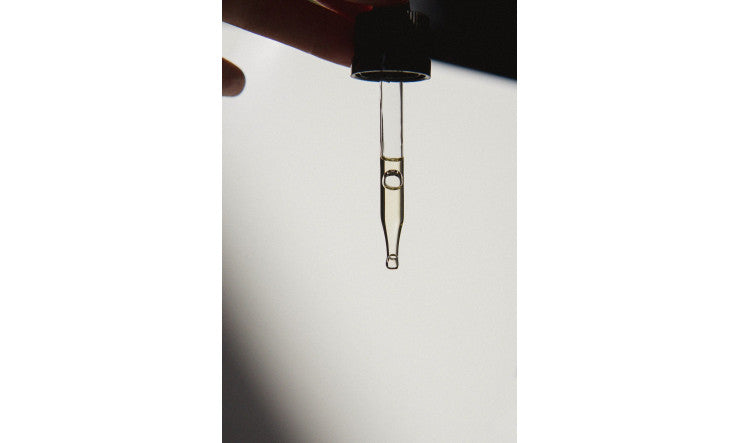Pierre Haddad, researcher & scientific director presents his two formulas for metabolism & glucose
What a wonderful, touching pride when he received his products yesterday!
Meeting with Pierre Haddad, biomedical researcher & scientific director
What a wonderful encounter! I invite you to listen to it directly here to discover a golden partner, presented by Jean-Yves Dionne (some time ago, his student) with honor, you will understand.
I feel fortunate to be at the meeting point between science and the power of plants, accompanied by such an eminent figure, ultimately wishing for your well-being.
So, as you listen, you will experience it, Dr. Haddad (or Pierre because he is also humble and touching), engaged in a process of extraordinary scientific rigor (the bar being higher navigating in the natural environment), has developed over fifteen years beautiful formulas from amazing medicinal plants - and obviously which have proven their scientific worth - responding to the needs revealed from his field of expertise which includes, among others, nutritional needs, functional foods, nutraceutical products and for 30 years, metabolic diseases, diabetes, obesity.
During our first conversation at the beginning of the year, I learned that his formulations, the fruit of a history rich in exceptional experiences, were gathering dust in a drawer. So, "Pierre, we can bring them to life!"
And so, yesterday, he received Gluconig and Metabzen at his home, as moved as we were this morning. And here we are at the beginning of a beautiful story with this desire to help maintain well-being through plants.
- Gluconig, a happy blend of nigella seeds and brown algae, regulates blood glucose.
- Metabzen helps maintain the body's ability to metabolize nutrients, supports liver function, protects tissues from oxidative stress, and improves carbohydrate metabolism. This impressive Haddad cocktail serves as a combination of several traditional formulas.
Gluconig and Metabzen are complementary and completely innovative. Listen and read here. You'll understand my excitement and this wonderful new milestone marked by this strong collaboration.
- Pierre S. Haddad Ph.D., researcher and member of INAF, president of the research on natural health products in Canada which he founded in 2003.
- Family History: Born in Egypt to a Syrian father and an Italian mother, he arrived in Canada at the age of four and a half. He attended an English-speaking school during his teenage years because his parents wanted him to be bilingual. Very early in CEGEP, he had a class on chemistry and society; his teacher talked about cleaning products of all kinds, because chemistry is everywhere in our society, and he talked about medications, and that really gave him a taste for understanding how these medications worked.
- He is a pharmacologist. To differentiate himself from pharmacists, pharmacologists study more the action of drugs (pharmacodynamics) and also the fate of drugs, how the body transforms drugs (pharmacokinetics). Pharmacists know this too, but pharmacologists are more at the level of understanding and designing drugs. He does not practice pharmacy, he is a PhD, therefore a university researcher at a major research university in Canada.
- A few years ago, he created Phytothera, a consulting company to offer his services and expertise in natural health to various companies.
- In 1998, he attended a conference, being a classic biomedical researcher, at that time, he was studying the action of insulin at the level of liver cells, for example, and also liver transplantation. Metabolic diseases, in general, how the body manages nutrients, whether sugars, fats, proteins, etc. He is associated with the Department of Nutrition, as an associate researcher at this university. He is also a professor of nutrition, on modes of action.
- The inspiration for his work came at this famous conference in Morocco and his colleagues were working on liver transplantation but they were also working on plants for diabetes. There was a symposium on medicinal plants; he found it really interesting and asked himself the question: "How come there isn't a lot of research on this?" There was a plant in which they were partly interested and he himself did a little research among herbalists & naturopaths, people knowledgeable in medicinal plants and nigella came out (a spice that is widely used and originates from the Mediterranean region and Asia, Turkey, India too. It's really a spice that is used much more in Mediterranean and Asian cuisine than some people know, it's a small black seed that has a particular smell.
- His colleagues were studying the antidiabetic activity of this nigella, so he started there. But the real opportunity came when (a true story of human chemistry) he met people because he knew that a pharmacologist cannot study medicinal plants alone, he needed a botanist, a plant chemist; so, he began to build a multidisciplinary team around him, Alain Cuerrier (botanist at the Montreal Botanical Garden) invited him to another conference where people from indigenous communities were opening their hearts because, unfortunately, there were thefts of their traditional knowledge, and this made him think that indeed traditional indigenous medicine used plants and diabetes was really a serious condition (indigenous population is 3 to 5 times the rate higher than the normal population "Approximately 7% of people in Quebec have type 2 diabetes while in the indigenous population, it can rise to 20-25%).
- He began working with the James Bay Cree because it was a major health issue.
Why these numbers?
- There are several theories, the most popular or most supported of which is that there were significant social dietary changes, there was also mechanization; indigenous communities were very physically active (canoeing, snowshoeing, etc.) and gradually the devices arrived, motorboats, snowmaking equipment, so a decrease in physical activity and at the same time an increase in what we call Western food (our southern food which moved north in its populations and there too, rich in sugar, fat, processed foods, simple sugars which are absorbed quickly.
- All of this put together created metabolic imbalances because there was also a theory that they still lived in arid or difficult conditions, especially in the North, with cycles of famine and plenitude when they killed animals and harvested fruits. It's not a theory that is necessarily proven but it can contribute. So, there are what are called energy saving genes so they are perhaps more efficient energy sensors, this is a survival advantage when we are in difficult conditions but when we have a diet rich in fat and sugar, it accelerates a little obesity, metabolic problems etc. The most important risk factors for diabetes and cardiovascular diseases. Ultimately, we don't die from diabetes, we die from complications including liver problems, cardiovascular problems, blindness (loss of sight is largely caused by diabetic retinopathy, kidney problems, diabetic nephropathy, loss of sensation because diabetics have to be very careful with their feet, because they injure themselves and they don't feel it, so there is a problem with the nerves and it can become infected, gangrenous, there are amputations. Diabetes is also the primary cause of non-traumatic amputations (not related to an accident).
- It is truly a serious modern disease and unfortunately it is very much linked to metabolic problems and that is why he was interested in it.
- It increasingly affects children; the youngest ones who begin to have metabolic symptoms, therefore disorders in the regulation of sugar and fats.
To continue his story
- He built this team and also joined forces with endocrinologists (specialist doctors who look at different hormones including insulin and glucagon, the two hormones that regulate blood sugar). These researchers (advisors) do studies on medications and they were also interested in the aspect of medicinal plants. Also, the Cree Board of Social Services was his important partner. They had a team built over the years, including seven laboratories from three major universities; they looked at things from several angles, because the intestine through which nutrients are absorbed, including glucose, can be a target, and also, they looked at the targets of medications that exist to try to reduce the absorption of sugar in the blood. Then, the main organs that are targeted by insulin: first, the pancreas, which produces insulin in response to changes in sugar; in fact, it responds to the increase in blood sugar to store it in the liver and to slow down production because the liver can store sugar. when we have a lot of it and can also produce it, it is the only organ with the kidney, a little bit, which can produce glucose from fats and amino acids, therefore from food and other nutrients. The liver is a bit like our metabolic factory and that is also why fatty liver is a disease which is an accumulation of fat in the liver which makes insulin work less well, there is a kind of sensitivity which we call insulin resistance.
The liver is truly a key organ in the body's entire metabolism.
- He was studying, precisely before working on plants, he was interested in this disease called fatty liver which causes liver problems and he was trying (with his colleagues) to improve this. They looked at the different organs that respond to insulin, we talk about the liver but there are the skeletal muscles which bring in glucose in response to insulin to use it (with movements, we burn energy). Glucose provides a little of the body's energy, then there are fats which store excess sugar in the form of fat which also react to insulin. There are different types of fats; some fats, if we accumulate too much of them, contribute to creating a small level of inflammation in the body. We hear a lot about inflammation, oxidative stress; in life, there are plenty of prevention approaches especially with natural health products; We talk about super fruits that are super antioxidants, things like that. Oxidative stress comes a lot because glucose contains a lot of oxygen in the molecule, so it creates oxidative stress and there's a lot of it in the body.
- Inflammation is also important, because many chronic diseases have inflammation as a component. Inflammation is a normal condition of the body to defend itself when we get injured, for example, it becomes red, it hurts, it swells; these are all reactions of the inflammatory system and when it heals, everything disappears. But chronic diseases like obesity, cancer, Alzheimer's etc. there is a low inflammation component that does not cause this swelling, pain or all that. It contributes but it is not like an injury, that is acute inflammation. We talk about mild chronic inflammation and that also unbalances the metabolism in the body.
- Skin fat is good fat, but not the fat in the abdominal cavity. We usually look at the body mass index (BMI), an index between height and weight, and we use BMI a lot to categorize people, say, as normal, overweight or obese and different types of obesity grade 1, 2, 3, etc.
- Researchers at Laval University have actually discovered that waist size is a very precise indicator that really correlates with metabolic problems as well. Through further study, they have understood that this abdominal fat produces more inflammatory molecules and disrupts the body more than other fats. The purpose of fat is that if there is too much energy in the body, too much glucose, for example, we will store it in the form of fat. At a certain point, the capacity of adipose tissue is overflowing and that's when it accumulates in the liver, in the muscle, and insulin resistance sets in, causing insulin to no longer be able to manage sugar properly, and sugar begins to rise. It's a very pernicious disease because we don't have symptoms, we don't feel bad; there are imbalances that occur in the body but which don't necessarily have consequences. It can take 5-10-15-20 years before you start to have complications from diabetes.
- Prevention. We're not talking about curing diseases, we're talking about helping people prevent metabolic disorders. All he's explaining is precisely the approach they took by understanding how metabolic diseases develop and which are the key organs. They had about twenty tests on different tissues, on oxidative stress, inflammation, the difference between the different organs he mentions; they established a fairly comprehensive research platform to study this.
- The more he studied plants, the more he thought about several elements, namely, if we really want to help people prevent metabolic diseases, we should have something that helps the liver, inflammation, oxidative stress and also helps the body to manage nutrients well and then glucose in particular.
This formula, which he has been simmering in his head for at least 15 years, is the culmination of much thought and is based on scientific evidence. Working with natural health products, he was forced to raise the bar.
(He draws inspiration from what he does for himself to create formulas he developed with MJ.)
26:25 - He was trained in the dogma of the silver bullet, the bullet that will hit a target that will solve the problem (e.g.: antibiotics). Plants have thousands of compounds. The more complex the diseases, the more targets there are that can be acted upon. For example, several areas of the pancreas and liver can be targeted to control sugar.
28:18 - The formulas were in the drawers, they are all-in-one formulas - introduction. He wanted to help people, he went back to school in herbalism, he wanted to combine science and tradition.
34:16 - Gluconig blood glucose regulator: margin of innovative Quebec product Insea2?
- The glycemic index measures how quickly sugar can enter the bloodstream. A high glycemic index is found in foods that contain simple sugars (e.g., slices of white bread or chocolate) that can enter the body very quickly, so the pancreas sends a signal of high sugar in the body. Insulin is secreted and rises quickly to control glucose, followed by a "down" because the insulin works so well, it succeeds in lowering glucose, and hypoglycemia can follow.
- Slow sugars (dietary fiber) have a low glycemic index, they enter the blood more slowly.
- Insea2 reduces the conversion of complex sugars into simple sugars, which lowers the glycemic index of foods. This doesn't mean eating chocolate and taking Gluconig. Prevention starts with healthy lifestyle habits (eating well, exercising, etc.).
- The algae blend made by Innovactiv is the Quebec side of the product and the Mediterranean part is the black seed, which helps the muscles, liver, and pancreas. He had the idea of combining the two ingredients.
- Can a diabetic take it? It doesn't replace medication; rather, it helps reduce the sugar rush when eating and slows down fat absorption. Black seed helps the body better manage sugar.
41:57 - Dosage 1 capsule before a meal 2 times a day, 30 min before the meal.
To help reduce the glucose spike after a meal and maintain healthy blood levels and it can be used even if you do not have conditions, it cannot unbalance the system in a normal individual, but can mitigate the effect of fast sugars so not bad for a healthy individual.
49:48 - Metabzen formula developed over the years with this understanding of metabolic diseases to act on several levels. Group of natural compounds to manage glucose. Contains plants for blood glucose:
- Natural Ginseng : Can help manage blood glucose in different metabolic conditions.
- Chromium : Essential mineral element; for many enzymes related to nutrient management and insulin response. Studies show it helps maintain healthy levels.
- Nigella
- Also contains liver-supporting herbs: milk thistle
Pierre has published over 150 publications in his career, including over a hundred on natural health products.
His studies have been peer-reviewed and published in the most reputable journals possible. It is difficult to get published in these biomedical or classical journals because there is a lot of skepticism and these kinds of studies do not go into the dogma of the molecule that acts on a single target, so pharmacologically it is very complex and the major medical or specialty journals are very cautious. He is happy to embark with Maison Jacynthe and to help by bringing his experience and expertise because we are serious and want to rely on science. He is very touched to see the fruit of several years of reflection come out in a bottle.
54:47 - Metabzen dosage: 1 capsule, once or twice a day.
- Also contains plants that act on inflammation : turmeric is one of the most recognized anti-inflammatory plants but also acts on the liver in combination with milk thistle . It manages stress due to inflammation
- Vitamin D : Vitamin D deficiency = higher risk of metabolic disease.
- Vitamin E : Oil-soluble antioxidant aspect will protect against oxidative stress in membranes that contain glucose transporters and enzymes. Helps break the cycle of toxic lipid generation in the liver.
58:19 - We can take the 2 products together, they are complementary.
- Gluconig : more specific to manage glucose absorption and management.
- Metabzen : more comprehensive for metabolic disease in general with a multifunctional approach, it brings together the equivalent of 5 formulations.
Often, a mixture of molecules is more effective than a single molecule, but sometimes it's the other way around. Many medications are natural products or derivatives of natural products. Even today, estimates suggest that 40-60% of the most prescribed medications have some kind of natural link.
These products are carefully thought-out and designed blends made from ingredients that have scientific evidence that Health Canada recognizes and that gives rise to the information found on the bottles. If the claims are allowed, it is because Health Canada and other organizations around the world consider the evidence sufficient to display these claims. This is the beauty of the Canadian system, which is a good balance between the traditional and the scientific.
1:04:00 - Who are these products for and how long should they be taken? - They do not affect body weight. Black seed may help, but there is no conclusive evidence. However, it is the effects of fat accumulation that lead to metabolic disorders that can be better managed with Metabzen. It affects the well-being of the overall metabolic system, affects several organs and aspects of metabolic disorders, including oxidative stress and inflammation, and helps organs better manage metabolic disorders. Can be taken regularly. Check the labels for contraindications.
- Gluconig : more to help slow down the absorption of sugars and have less impact of the meal on blood sugar, on blood glucose at mealtime.
Natural health products are health management tools aimed at prevention. The modern healthcare system focuses on symptom management and disease treatment.
1:09:56 - Contraindications
1:11:43 - If you have the beginnings of an increase in waist size (a precursor to metabolic imbalance): start using it as a preventative measure.
1:12:31 - If you already have an imbalance: present the products to your doctor to begin use while monitoring blood glucose to avoid hypoglycemia.
If you have fatty liver, Metabzen can help.
1:20:28 - Regulation of self-care products includes: shampoos, toothpastes, cosmetics and natural health products.
1:21:51 - Summary of the usefulness of the 2 products
Pierre will write popularized texts to help doctors understand these products, which are health management tools, just like healthy lifestyle habits.


































































Leave a comment